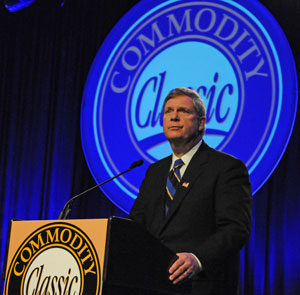 U.S. Secretary of Agriculture Tom Vilsack spoke to the crowd at Commodity Classic just moments ago. You can listen to his full speech below. Joanna is attending his press conference right now and I’ll post audio from it later. Some of the standout phrases I heard included, “Different strategies for different markets” when he was talking about expanding world trade. He also said, “Rural America is the heart and the soul and the guts of America” when talking about revitalizing rural America.
U.S. Secretary of Agriculture Tom Vilsack spoke to the crowd at Commodity Classic just moments ago. You can listen to his full speech below. Joanna is attending his press conference right now and I’ll post audio from it later. Some of the standout phrases I heard included, “Different strategies for different markets” when he was talking about expanding world trade. He also said, “Rural America is the heart and the soul and the guts of America” when talking about revitalizing rural America.
Here are some of the points he made in his remarks taken from the USDA release:
Agriculture Secretary Tom Vilsack today discussed USDA’s work to strengthen the American agriculture economy and revitalize rural communities in the keynote speech at the 2010 Commodity Classic in Anaheim, Calif. Vilsack focused on the USDA’s efforts to increase exports of agricultural products to help American farmers, ranchers, and workers.
“USDA’s continued work to expand trade opportunities for America’s hard-working farmers and ranchers will play an important role in our effort to rebuild rural communities across the country,” said Vilsack. “Increased trade will not only create important income opportunities for producers, but also the off-farm jobs that are so critical for revitalizing rural America.”
While USDA has traditionally looked at agricultural trading partners by geographic region, under the new trade strategy outlined by Vilsack, USDA looks at countries based on their position on an agricultural market continuum, which enables tailored strategies to increase exports to each individual market. The continuum goes from fragile markets/food security states, to potential growth markets, to restricted access markets, to rapid growth markets, to developed consumer markets. The new strategy will improve collaboration among USDA agencies and guide priorities for international staffing, foreign assistance, and agricultural research.
For example, in potential growth markets, USDA programs will now emphasize building the institutional and human capacity needed to support increased trade, while in restricted access markets, USDA efforts are designed to remove trade barriers. In rapid growth markets, USDA will now emphasize using a full range of programs to build trade capacity, remove trade barriers and develop new markets for U.S. products.
Commodity Classic Photo Album
AgWired coverage of the 2010 Commodity Classic
is sponsored by:  and
and 




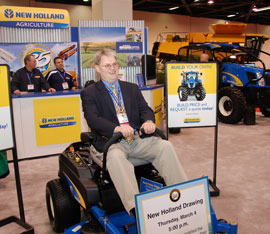 Hopefully, Scott Richert’s wife believes him by now. He really did win the
Hopefully, Scott Richert’s wife believes him by now. He really did win the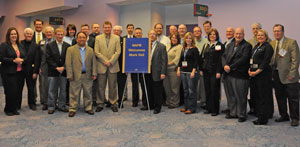 Members of the
Members of the 

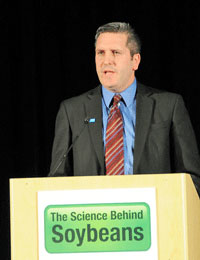 “The soybean market has great potential for growth but yields haven’t increased that much in the last few years so what we really see is an opportunity is to get more from every acre by using some different practices and new technologies such as the new Kixor herbicide technology that BASF has,” said Paul Rea, Director of BASF US Crop Protection Division.
“The soybean market has great potential for growth but yields haven’t increased that much in the last few years so what we really see is an opportunity is to get more from every acre by using some different practices and new technologies such as the new Kixor herbicide technology that BASF has,” said Paul Rea, Director of BASF US Crop Protection Division.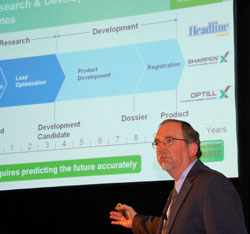 BASF Technical Service Manager Rick Chamblee says Kixor, which is the active ingredient in a number of new products that were just approved for use in this country last fall, is a great example of how BASF looked ahead to anticipate grower needs in the future. “When we started working on the Kixor family of products 9-10 years ago, glyphosate tolerant weeds were not even on the horizon,” Rick said. In fact, only one weed was resistant in the United States, today there are six broadleaf weeds that are tolerant to glyphosate that are commonly found in soybean production.
BASF Technical Service Manager Rick Chamblee says Kixor, which is the active ingredient in a number of new products that were just approved for use in this country last fall, is a great example of how BASF looked ahead to anticipate grower needs in the future. “When we started working on the Kixor family of products 9-10 years ago, glyphosate tolerant weeds were not even on the horizon,” Rick said. In fact, only one weed was resistant in the United States, today there are six broadleaf weeds that are tolerant to glyphosate that are commonly found in soybean production.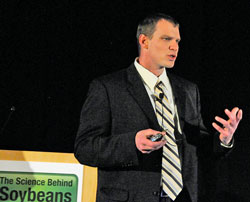 The average soybean yield in Illinois has been 45-46 bushels per acre the last two years, which Vince says has been pretty consistent for the past five years and growers would really like to see that improve by at least two bushels per acre. They would really like to see yields as high as the 100 bushels per acre that Kip Cullers sees on his farm, so Vince took a closer look at what Kip does last year to bring back to Illinois. “There’s a lot we have left to learn on how to maximize each individual plants’ productivity in soybean and really approach some of the levels of individual plant management like we’ve been doing in corn,” said Vince. He stresses the importance of early weed control as something growers can do to help improve yields. “Controlling weeds, starting with a clean field and making sure you don’t lose bushels to weeds early in the season is very important,” Vince said.
The average soybean yield in Illinois has been 45-46 bushels per acre the last two years, which Vince says has been pretty consistent for the past five years and growers would really like to see that improve by at least two bushels per acre. They would really like to see yields as high as the 100 bushels per acre that Kip Cullers sees on his farm, so Vince took a closer look at what Kip does last year to bring back to Illinois. “There’s a lot we have left to learn on how to maximize each individual plants’ productivity in soybean and really approach some of the levels of individual plant management like we’ve been doing in corn,” said Vince. He stresses the importance of early weed control as something growers can do to help improve yields. “Controlling weeds, starting with a clean field and making sure you don’t lose bushels to weeds early in the season is very important,” Vince said.